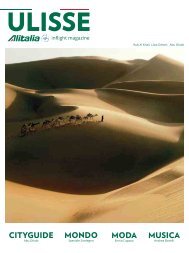You also want an ePaper? Increase the reach of your titles
YUMPU automatically turns print PDFs into web optimized ePapers that Google loves.
per qualche minuto mentre muove impercettibilmente le mani, o si<br />
aggiusta gli occhiali, oppure osserva con interesse e partecipazione<br />
un avvenimento che non ha nulla a che vedere con l’argomento di<br />
cui sta parlando con il suo interlocutore. In quel momento sta ‘mettendo<br />
insieme’ fatti diversi, realtà dissimili, moltiplicando concentrazione<br />
e idee. Un esercizio che riesce a pochissimi. Ma Geoffroy<br />
non è propriamente un enologo, o perlomeno è tornato a esserlo<br />
dopo una lunga deviazione professionale. È un medico. Dunque,<br />
è uno sperimentatore di formazione, un empirico. Gli piacciono le<br />
‘reazioni’: giustapporre agenti diversi e vederli reagire, scoprirne<br />
differenze e similitudini. Per questo, e nonostante i ‘papier’, tutte<br />
le carte in regola ottenute a Reims e poi in una prima esperienza<br />
da enologo nella Napa Valley, parla un linguaggio sconosciuto a<br />
qualunque altro collega. Da quella cena kaiseki, gli abbiamo visto<br />
creare i più inattesi ‘<strong>mar</strong>iage’ attorno al tema della creazione e<br />
dell’incontro fra opposti: uno nell’hotel particulier parigino di Karl<br />
Lagerfeld, grazie al quale Claudia Schiffer riemerse dal (relativo)<br />
oblio in cui si era confinata; un altro sulle rive dell’Oceano Pacifico,<br />
fra artisti indie di cui l’Europa non aveva ancora sentito parlare;<br />
un altro ancora con David Lynch sul filo del sogno e della follia, e<br />
poi un <strong>mar</strong>iage à trois fra Lang Lang, Adam Désplat e Bob Wilson,<br />
oltre a un affondo con l’artista più pagato della scena artistico-pop<br />
contemporanea, Jeff Koons, attorno al tema della sensualità che<br />
è particolarmente caro a entrambi. Adesso che Dom Perignon ha<br />
deciso di sostenere il restauro di due sale di Ca’ Pesaro, a Venezia,<br />
trovando un punto di contatto con il direttore della Fondazione Musei<br />
Civici di Venezia, Gabriella Belli, nella promozione dei giovani<br />
artisti (l’accordo, creato nell’ambito del progetto mondiale “The<br />
Power of Creation”, ha debuttato con una fusione e contrapposizione<br />
fra i teleri di Giulio Aristide Sartorio “Il Poema della vita<br />
umana” realizzati per la Biennale d’Arte del 1907 e i suoni, rituali<br />
e ossessivi, del trentenne Alberto Tadiello in una mostra dal titolo<br />
“Paradossi”), Richard Geoffroy siede sulla terrazza del Gritti con<br />
l’aria del chimico di laboratorio che ha appena infilato il reagente<br />
in una fialetta. «Abbiamo valutato diversi artisti prima di scegliere<br />
questo giovane artista vicentino», dice, già convinto che la reazione<br />
sarà positiva presso i pubblici più diversi. A differenza della corrente<br />
di pensiero no global che esecra anche la più remota possibilità<br />
di un’omologazione del gusto mondiale come risultato delle politiche<br />
commerciali e logistiche delle multinazionali del beverage,<br />
del design e della moda, Geoffroy ritiene la vicinanza dei desideri<br />
e delle aspirazioni non solo un fatto positivo, ma anche il risultato<br />
di un’evoluzione culturale: «Se gusti e attese si fanno simili in tutto<br />
il mondo, significa che le barriere culturali sono meno forti e le<br />
differenze si possono abbattere. Sinceramente, non trovo in questo<br />
nulla di male, anzi; proprio il contrario». Il principio sarebbe validissimo,<br />
non provenisse da un manager che sulla globalizzazione<br />
“L’ Amore” uno dei teleri di Giulio Aristide Sartorio<br />
Il cocktail party di Dom Pérignon alla Ca’ Pesaro dopo il restauro<br />
Una delle sale di Ca’ Pesaro<br />
different facts, dissimilar realities, multiplying focus and ideas. An<br />
exercise that very few manage. But Geoffroy is not really a wine expert,<br />
or at least he returned to being one after a long professional<br />
detour. He is a doctor. Therefore, he is an investigator of training, an<br />
empiricist. He likes “reactions”: to juxtapose different agents and see<br />
them react, discovering differences and similarities. Because of this,<br />
and despite the “papiers”, all the credentials obtained in Reims and<br />
then during his early experience as a winemaker in the Napa Valley,<br />
he speaks a language unknown to any other colleague. From that<br />
kaiseki dinner, we saw him create the most unexpected “<strong>mar</strong>iages”<br />
on the theme of creation and the encounter between opposites: one<br />
in Karl Lagerfeld’s Parisian hotel particulier, from which Claudia<br />
Schiffer emerged from (relative) oblivion; another on the shores of<br />
the Pacific Ocean, among indie artists still unknown in Europe; yet<br />
another with David Lynch on the subject of dreams and madness; and<br />
then a <strong>mar</strong>iage à trois between Lang Lang, Adam Desplat and Bob<br />
Wilson, plus a lunge with the highest paid artist on the contemporary<br />
pop-art scene, Jeff Koons, around the theme of sensuality, particularly<br />
dear to both. Now Dom Perignon is supporting the restoration<br />
of two halls on Ca ‘Pesaro in Venice, finding a point of contact with<br />
the director of the Civic Museums Foundation of Venice, Gabriella<br />
Belli, in the promotion of young artists. The agreement, part of the<br />
global “the power of creation” project, debuted with a fusion and<br />
juxtaposition between the canvases of Giulio Aristide Sartorio, “The<br />
Poem of Life” made for the Art Biennale in 1907, and the ritual and<br />
obsessive sounds of Alberto Tadiello in an exhibition entitled “Paradoxes”.<br />
Richard Geoffroy sits on the terrace of the Gritti with the air<br />
of a laboratory chemist who has just put a reagent into a vial. “We<br />
evaluated several artists before choosing this young artist from Vicenza”,<br />
he says, already assuming a positive reaction from diverse audiences.<br />
Unlike the no-global current of thought that denies even the<br />
remotest possibility of standardised global taste as a result of trade<br />
policies and logistics of beverage, design and fashion multinationals,<br />
Geoffroy believes the proximity of wishes and aspirations is not<br />
only a good thing, but also the result of cultural evolution: “If tastes<br />
and expectations are similar around the world, cultural barriers are<br />
weakened and differences can break down. Honestly, I do not find anything<br />
wrong in this, indeed, just the opposite”. The principle would<br />
be very valid, if it didn’t come from a manager who has built his for-<br />
ULISSE MARZO 2015 61




